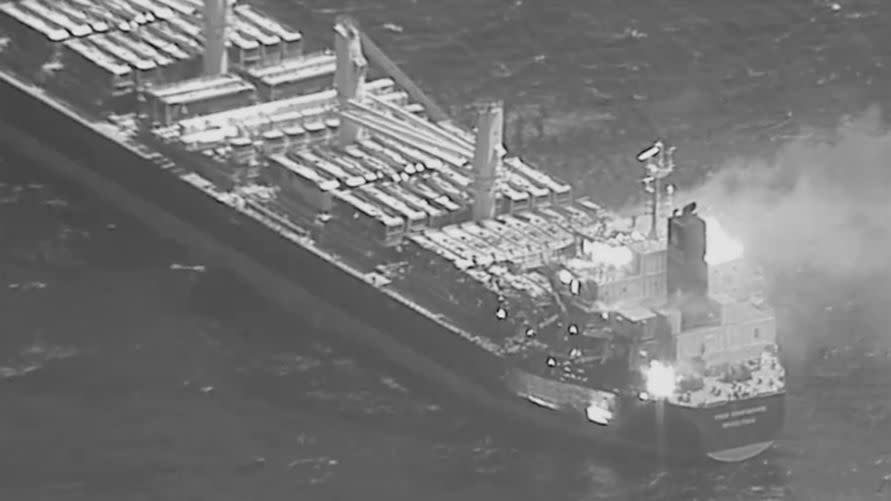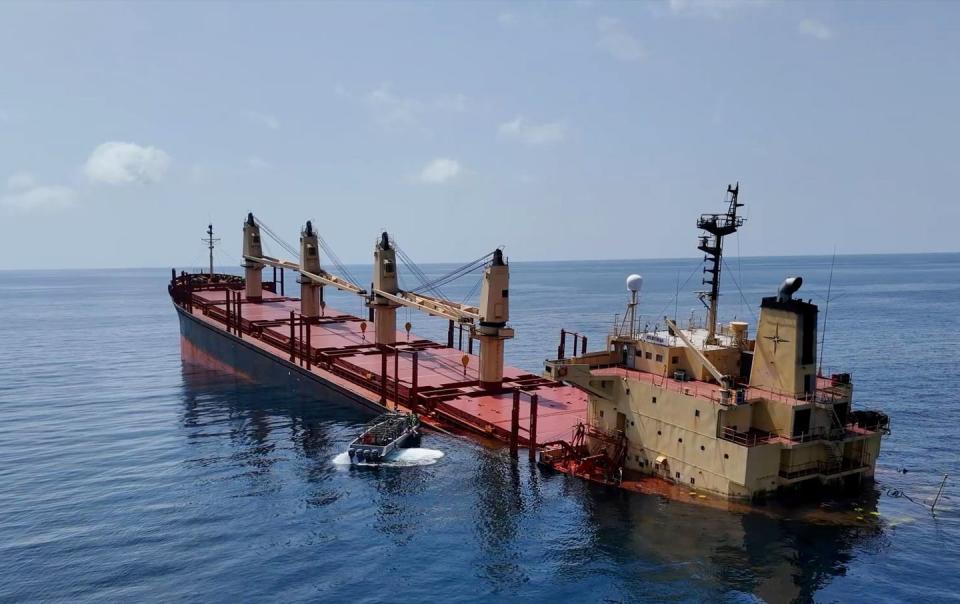For the First Time, Houthi Missiles Have Drawn Blood

Since the outbreak of the Hamas-Israel conflict in October of 2023, Houthi rebels controlling western Yemen have been launching a mix of drones and missiles to show their support for Hamas—first targeting Israel before redirecting their fire at civilian and military shipping off the coast of Yemen.
For five months, none of the hundreds of missiles and drones launched managed to kill anyone—though, a few did manage to strike commercial shipping in the Red Sea and Gulf of Aden. Only one attack managed to sink a vessel (see below).
But that changed abruptly this Tuesday, when an anti-ship ballistic missile (ASBM) slammed into the bulk carrier M/V True Confidence at 9:30 or 11:30 AM (sources differ) while it was transiting westward down the Gulf of Aden bound at 13 knots. Nearly as long as two football fields, True Confidence was bound to arrive at the Saudi Red Sea port of Jeddah the following morning to deliver a cargo of Chinese steel products and trucks.
The Houthis have claimed responsibility for a missile attack on the cargo ship True Confidence in the Gulf of Aden, sparking a fire onboard.
🔴 LIVE updates: https://t.co/alpT4f8A6W pic.twitter.com/msplel8F4X— Al Jazeera English (@AJEnglish) March 6, 2024
A Houthi spokesperson subsequently took credit for the attack, which struck the ship 62 miles southwest of the port of Aden, triggering a fire on deck and causing a column of smoke to rise into the sky.
UKMTO WARNING INCIDENT 046
UPDATE 003
ATTACK
Warnings - 2024 (https://t.co/5An1YH0JyE)#MaritimeSecurity #MarSec pic.twitter.com/IOQ232ho1y— United Kingdom Maritime Trade Operations (UKMTO) (@UK_MTO) March 6, 2024
Of the 20 crew and three armed guards aboard, 21 were rescued, of whom five or six were seriously injured, including one person who succumbed to mortal injuries.
The crew was primarily comprised of Filipino and Vietnamese citizens, while its guard detachment hailed from Sri Lanka and Nepal. It did not include any Americans or Israelis. The crew has since been landed at Djibouti to receive additional medical aid.
Today around 2 PM local time, the MV True Confidence was attacked in the Gulf of Aden, 70 NAUTICAL MILES off the coast of Djibouti.
The ship was rescued by the INS Kolkata, an Indian warship. The Djiboutian Government was mobilized for this critical humanitarian mission.
This… pic.twitter.com/PlvWonXt1t— Djibouti Ports & Free Zones Authority (@dpfza) March 6, 2024
The crew abandoned ship and took to lifeboats, leaving the crippled ship ablaze and at risk of sinking. Indian Navy destroyer INS Kolkata was first to respond, and picked up the surviving crew. Meanwhile, the U.S. Navy’s Ticonderoga-class missile cruiser USS Philippine Sea is bound towards the abandoned tanker.
True Confidence was formally a Barbados-flagged tanker owned by a U.S. company, and had earlier come under attack supposedly on the basis that it was owned in part by an American company. However, it had recently been re-registered to Liberia, and transferred to ownership by Greek company Third January Maritime LTD.
In the prior 48 hours, Houthi forces had launched four ASBMs, one of which also struck MSC Sky II and another which was shot down. True Confidance had ignored a radio message from the rebels ordering them to halt and await boarding. In the past, such messages were observed to be a ploy to compel vessels to stop moving so they could be more easily hit with a subsequent ballistic missile attack. The Houthi attackers were likely unaware of the re-flagging, though it’s far from clear whether or not that would have mattered.
Two U.S. air strikes subsequently hit the airport at the Houthi-held city of Hudaydah, but whether they had any connection to the anti-ship attack is unclear. The day prior, between 3:00 and 9:40 PM, the Houthis targeted the destroyer USS Carney with four cruise missiles, four ballistic missiles, three naval kamikaze drones, and three aerial kamikaze drones—all of which were shot down short of target.
The Iranian-back rebels testing new maritime weapons of war
The Houthi rebels controlling most of Western Yemen are unusually well armed, thanks to a mix of weapons inherited from Yemen’s army and transferred from Iran (sometimes directly, but often for local assembly and redesign).
As part of their anti-Israel campaign, the group has employed anti-ship cruise missiles, land-attack and anti-ship ballistic missiles (ASBMs), and kamikaze drone boats. Warships from the U.S., UK, France, Germany, and Italy have destroyed drones and missiles with their own air defenses, using missiles (confirmedly including SM-2s and Asters), deck guns, and robotic autocannons known as Close-In Weapon Systems (CIWSs). U.S. Harrier jump jets and F/A-18 Super Hornets, as well as Israeli F-35s and Saudi F-15s, have downed additional drones and missiles.
As a result, not one Houthi strike has landed on a military target.
However, the military air defense umbrella has not managed to protect every civilian ship targeted, and many were hit. The only civilian vessel ultimately destroyed, however, was the Belize-flagged Rubymar. It was hit by an ASBM on February 18, and managed to remain afloat until March 3. Fortunately, all 24 onboard were rescued, but the over over 23,000 tons of ammonium phosphate fertilizer aboard will have long-term ecological impacts.

Following a large-scale attack, in January, U.S. and British warplanes began attacking Houthi forces in Yemen in an attempt to suppress the anti-ship attacks. They destroyed several drones, missiles, launchers, and targeting radars on the ground at the cost of one MQ-9 drone shot down. However, the strikes don’t appear to have overtly decreased the volume of Houthi drone and missile attacks, which actually doubled in February.
The missile that struck True Confidence is an anti-ship ballistic missile, a type of weapon never used in combat prior to the Houthi anti-ship campaign. Like most ballistic missiles, these weapons fly on very high-lofted trajectories before plunging downwards at many times the speed of sound. The Houthi anti-ship attacks are initially guided to target using GPS coordinates of vessels obtained by spying drones.
But unlike traditional ballistic missiles designed to attack static land targets, when an ASBM begins its terminal dive, it activates a seeker on the nose that allows it to search for and lock onto a moving ship—if it remains with the narrow field-of-view of the seeker.
High-flying ASBMs are easier to detect than traditional surface-skimming anti-ship cruise missiles, but pose unique difficulties to bat down, thanks to their very high speed and steep trajectory. This has prompted the U.S. to deploy new naval air defense missiles specialized in ballistic missile defense. A fast-enough ship, given adequate early warning, may be able to ‘dodge’ an ASBM by changing course and racing outside the ‘kill zone’ scanned by its seeker.
Though ASBMs, in theory, impact ships with tremendous kinetic forces in addition to their explosive payloads, Houthi ASBM hits on civilian ships had not caused fatalities before this recent attack. This is in part due to large commercial shipping involving vast ships with small crews.
But that good fortune ran out for the crew of True Confidence on Tuesday. Time will tell if the fires on Confidence can be quelled, and the ship brought safely back to port.
It is possible that Tuesday’s lethal attack reflects improved methods adopted by the Houthis. But it may simply have been inevitable, given the large volume and lengthy duration of the Houthi campaign interdicting the waters off the coast of Yemen.
You Might Also Like


